
Capitol stories: taking you inside the capitol! Choose by historical era, themes, or specific stories.
- Subject:
- History
- U.S. History
- Material Type:
- Interactive
- Provider:
- United States Capitol Historical Society
- Date Added:
- 04/05/2023

Capitol stories: taking you inside the capitol! Choose by historical era, themes, or specific stories.

Cardinal, CO Mining Town. Western Mining History presents a brief summary of Colorado's Historical Mining Towns with links to additional Colorado resources for a mining town database and mines by county. Western Mining History is an historical site that provides information on mining, mining towns, the gold and silver rush, and Photos and maps of the western United States. This is a strong primary source resource that can be used for a variety of class research projects. Consider becoming a member or making a donation to help further the work of the site.
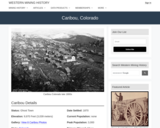
Caribou, CO Mining Town. Western Mining History presents a brief summary of Colorado's Historical Mining Towns with links to additional Colorado resources for a mining town database and mines by county. Western Mining History is an historical site that provides information on mining, mining towns, the gold and silver rush, and Photos and maps of the western United States. This is a strong primary source resource that can be used for a variety of class research projects. Consider becoming a member or making a donation to help further the work of the site.
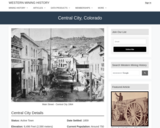
Central City, CO Mining Town. Western Mining History presents a brief summary of Colorado's Historical Mining Towns with links to additional Colorado resources for a mining town database and mines by county. Western Mining History is an historical site that provides information on mining, mining towns, the gold and silver rush, and Photos and maps of the western United States. This is a strong primary source resource that can be used for a variety of class research projects. Consider becoming a member or making a donation to help further the work of the site.

Western Mining History presents a short history of a dredging unit from central Idaho used during the Gold Rush. The dredge was a mining technology brought into use after 1890. Western Mining History is an historical site that provides databases, information on mining, mining towns, gold and Photos and maps of the western United States. Consider becoming a member or making a donation to help further the work of the site. Visit the dredge site here: http://yankeeforkdredge.com/

Use a secret code to decipher a message about Cesar Chavez. Activity from Weekly STEM in a Bag. Colorado Americorp agents in Araphahoe, Denver, Garfield, Larimer, and Weld Counties. Work supported by the Corporation for National and Community Service under Americorps grant number 18AFHCO0010008. Opinions or points of view expressed in this lesson are those of the authors and do not necessarily represent the official position of or a position that is endorsed by the Corporation or the Americorps program. This resource is also available in Spanish in the linked file.
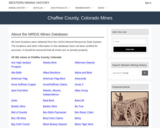
This Western Mining History database uses Mineral Resources Data System to list known Colorado historical mines by county. Each county site has links to the known mines within its borders. Some are known and named, others are unnamed. Mines should be assumed to be on private property unless other research is conducted. Data provided for each mine site include: Name, State, County, Elevation, Primary Mineral Mined, Latitude and Longitude and a link to Google Maps. Photos are provided where available. Additional information for some Mines are satellite photos, and ownership, business and historical records. Mining History is an historical site that provides information on mining, mining towns, the gold and silver rush, and Photos and maps of the western United States. This is a great database for student historical research or data and statistics classes. Consider becoming a member or making a donation to help further the work of the site.

The 20th century ushered in a change from handcrafting to machine tooling. Henry Ford introduced one of the first moving assembly lines as a way to turn out more cars more quickly, and the emerging auto industry popularized this mode. A photo of the Doble Steam Motors Corporation factory shows a line of workers and car chassis in production. This new technology, and the spread of industrialization, changed forever the way that work was completed. A wide variety of industries all across the country converted to mechanization, and California was no exception. One 1929 image shows young women working in a towel factory in Orange. Photographs taken in San Francisco illustrate that workers used machines to make products as different as Ghirardelli Chocolate and music rolls for automated player pianos. Images also show women working on an assembly line in a soap factory, and men sewing clothes in a shop (at a time when a good suit, cut on machines instead of by hand, retailed for $40 to $50). Automation and mechanization also changed agricultural practices. The combined traction steam harvester built by Stockton J. Barry on his California ranch was one of the machines that changed the way produce was harvested. Mechanized canning changed the way fruit and vegetables were processed and preserved, and made out-of-season produce available year round. Photographs in this group show cannery workers at tables, and cans going through a labeling machine. The introduction of mechanized food processing eventually brought a new awareness of the importance of standards for foods production. The Pure Food and Drug Act and the Meat Inspection Act were both passed in 1906. As workers nationwide adjusted to an increasingly mechanized workplace, good working conditions took on new importance. Workers in several industries formed unions (such as the Berryessa Fruit Growers formed in 1920, shown here) to promote safer working conditions and limit maximum working hours.

A selection of Library of Congress primary sources exploring charts and graphs. This set also includes a Teachers Guide with historical context and teaching suggestions.

Chattanooga, CO Mining Town. Western Mining History presents a brief summary of Colorado's Historical Mining Towns with links to additional Colorado resources for a mining town database and mines by county. Western Mining History is an historical site that provides information on mining, mining towns, the gold and silver rush, and Photos and maps of the western United States. This is a strong primary source resource that can be used for a variety of class research projects. Consider becoming a member or making a donation to help further the work of the site.

In this activity students will analyze documents that span the course of American history to see examples of "checks and balances" between the legislative, executive, and judicial branches in action. Students will then match the documents they have examined with an appropriate description of the branches of government involved in the action.
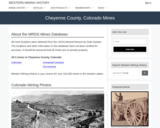
This Western Mining History database uses Mineral Resources Data System to list known Colorado historical mines by county. Each county site has links to the known mines within its borders. Some are known and named, others are unnamed. Mines should be assumed to be on private property unless other research is conducted. Data provided for each mine site include: Name, State, County, Elevation, Primary Mineral Mined, Latitude and Longitude and a link to Google Maps. Photos are provided where available. Additional information for some Mines are satellite photos, and ownership, business and historical records. Mining History is an historical site that provides information on mining, mining towns, the gold and silver rush, and Photos and maps of the western United States. This is a great database for student historical research or data and statistics classes. Consider becoming a member or making a donation to help further the work of the site.

In twenty-first century American society, childhood is popularly understood as a time of innocence, learning, and play. At the end of the nineteenth century, however, children made up part of the countrys workforce, and labored on farms and in factories. When they were not working, they enjoyed great independence in leisure activitiesbe it in a loud city street or a peaceful country lake. Often, children were far from adult supervision. Reformers during the Progressive Era period of social activism and political reform across the United States between the 1890s and 1920s took a great interest in child welfare. Through organizations and legislation, they sought to define what a happy and healthy childhood should be in the modern age. Immersion in nature was central to what the Progressives prescribed, and childrens organizations and camps offered a suitable combination of supervision and open spaces. The formula for a healthy childhood was further refined in postwar America. Children were given a distinct place in the family and home, as well as within the consumer market with the emergence of teenage culture and buying power. This exhibition was created as part of the DPLA's Public Library Partnerships Project by collaborators from the Digital Library of Georgia and Georgia's public libraries.

The unit will teach elements of civics and democracy through the lens of the Presidential election. Students will be asked to research, read, and write about various aspects of civics and democracy, using a wide array of multimedia resources that will include (but not be limited to) literature, music, visual arts, and technology. The goal of the unit is to help students understand the importance of voting and participation while building their knowledge of the election system. The unit will encourage your students to think about government in a new way and connect this remarkable election to their day to day lives. While this unit will be taught during the first marking period, the unit will work at any point throughout the next few years. It is a Social Studies based unit designed for middle school students, primarily in the sixth grade, but can be modified and adapted to fit high school curriculum, grades nine through twelve.

For many students, a trip to Washington, D.C. is a once-in-a-lifetime experience that opens their eyes to an exciting world beyond their classrooms. Discovery Education and First Lady Dr. Jill Biden welcome students to a behind-the-scenes Virtual Field Trip to experience the history and beauty of our nation’s capital.
Designed for students in grades 4-8, this action-packed tour features remarkable special guests and give viewers an inside look at six landmark locations:
The White House
The U.S. Capitol Building
The Supreme Court
The Martin Luther King, Jr. Memorial
Arlington National Cemetery and the Tomb of the Unknown Soldier
The Smithsonian National Air and Space Museum

In this activity students will learn about how groups without political power—African Americans, women, and working-class men—sought to expand their political power in the Revolutionary era. Students will analyze primary sources to determine the methods by which non-voting groups made their claims on being part of "We the People".
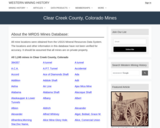
This Western Mining History database uses Mineral Resources Data System to list known Colorado historical mines by county. Each county site has links to the known mines within its borders. Some are known and named, others are unnamed. Mines should be assumed to be on private property unless other research is conducted. Data provided for each mine site include: Name, State, County, Elevation, Primary Mineral Mined, Latitude and Longitude and a link to Google Maps. Photos are provided where available. Additional information for some Mines are satellite photos, and ownership, business and historical records. Mining History is an historical site that provides information on mining, mining towns, the gold and silver rush, and Photos and maps of the western United States. This is a great database for student historical research or data and statistics classes. Consider becoming a member or making a donation to help further the work of the site.
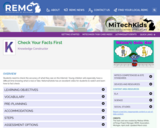
Cokedale, CO Mining Town. Western Mining History presents a brief summary of Colorado's Historical Mining Towns with links to additional Colorado resources for a mining town database and mines by county. Western Mining History is an historical site that provides information on mining, mining towns, the gold and silver rush, and Photos and maps of the western United States. This is a strong primary source resource that can be used for a variety of class research projects. Consider becoming a member or making a donation to help further the work of the site.

In this lesson students read a description of a slave's walk through colonial New York City and determine which laws he broke and which laws he followed. Students then write a journal entry from the perspective of either a slave or a slaveowner reacting to colonial New York's slave codes.

This collection uses primary sources to explore religion during the Colonial period of US History. Digital Public Library of America Primary Source Sets are designed to help students develop their critical thinking skills and draw diverse material from libraries, archives, and museums across the United States. Each set includes an overview, ten to fifteen primary sources, links to related resources, and a teaching guide. These sets were created and reviewed by the teachers on the DPLA's Education Advisory Committee.